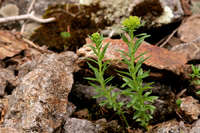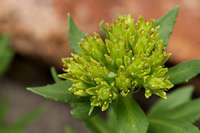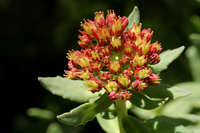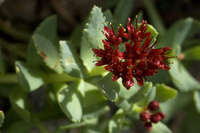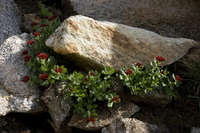Plants dioecious or polygamodioecious. Rootstock erect or spreading, to 1-5 cm diam. Floral stems deciduous, 3-50 × 0.1-0.7 cm. Leaf blades usually bright green, sometimes glaucous, elliptic to ovate or oblanceolate to linear, 0.5-5.5 × 0.2-1.5(-2) cm, margins entire or toothed, apex acute to obtuse. Inflorescences corymbose cymes, dense, to 250-flowered, to 8 cm diam. Pedicels ca. 2 mm. Flowers mostly unisexual, 4-5-merous; sepals lanceolate to ovate, 1.5-3 mm; petals mostly dark red, sometimes yellowish at base or yellow with apical 1/3 red, elliptic-oblong, 1.5-5 mm, shorter than stamens, in staminate flowers spreading, hooded, 1.3-1.7 mm wide, in pistillate erect. Follicles 4-9 mm, beaks spreading. Seeds winged, pyriform or oblanceoloid, 1.1-2.8 mm. 2n = 36.
The plants treated here as Rhodiola integrifolia and R. rosea are part of a difficult polymorphic complex of arctic to cool-temperate North America and Eurasia and of high mountains southward. Some authors have included them all in R. rosea [or Sedum rosea (Linnaeus) Scopoli], often with subspecies or varieties; N. L. Britton and J. N. Rose (1905) earlier divided them into two to several species.
For this complex C. H. Uhl (1952) cited six published chromosome counts from Greenland through Eurasia to Japan, all n = 11 or 2n = 22; he found the same numbers in seven collections from northeastern North America (all these Rhodiola rosea proper). From Eurasia, according to R. L. Taylor and G. A. Mulligan (1968), races with 2n = 16 and 33 also are known. On the other hand, for endemics in Minnesota and New York and for five plants from New Mexico and California, Uhl found n = 18 or 2n = 36, and Taylor and Mulligan likewise found 2n = 36 in plants of Moresby Island, British Columbia. With the support of five more counts, but with none for the large area of Oregon and Wyoming to the Bering Sea, R. T. Clausen (1975) separated the 36-chromosome plants as Sedum integrifolium. More counts of 2n = 36 have since appeared, including one from Sutwick Island, off the Alaska Peninsula (Á. Löve 1979).
In middle North America, Rhodiola integrifolia and R. rosea are geographically distinct. The local endemic subsp. leedyi of the former grows in Minnesota, midway between the western subspecies of R. integrifolia and the eastern R. rosea, and grows in New York state within 100 km of R. rosea. Otherwise, the ranges of the two species are over 2000 km apart in the south and nearly 3000 km in the north. Rhodiola integrifolia also is the prevailing plant in eastern Asia, where it has been named Sedum atropurpureum N. S. Turczaninow (E. Hultén 1941-1950, vol. 5), and R. rosea seems to extend (although not verified by chromosome counts) from eastern Asia to far-western Alaska, on the coast of the Bering Sea.
Although saying that Sedum integrifolium differs from S. rosea in many ways besides the chromosome number, R. T. Clausen (1975) found few absolute distinctions. His best key characters were those used here, petal width of staminate flowers, largely supported by flower color. Although questions remain unanswered, it seems best for now to follow Clausen in keeping the two species for North America.
Over its broad range, Rhodiola integrifolia is quite variable (e.g., see E. Hultén 1941-1950, vol. 5). R. T. Clausen (1975) noted that in some populations pistillate plants outnumber staminate; in others staminate may be six times as many as pistillate. He distinguished two outlying endemics as subspp. leedyi and neomexicana, also kept as subspecies here. He also proposed subsp. procer[a] for tall robust plants of Colorado, New Mexico, and (less typical) California, all within the range of subsp. integrifolia and all with the same chromosome number. Some of his plants look remarkably different from the usual dwarf forms of subsp. integrifolia that grow at the same high elevations. He did not include in subsp. procera (and apparently did not see alive) the tall plants often found inland in Alaska and northwestern Canada, which would be Sedum frigidum Rydberg according to Hultén. Thus the racial situation is much more complex than the naming of only two peripheral subspecies might suggest.



